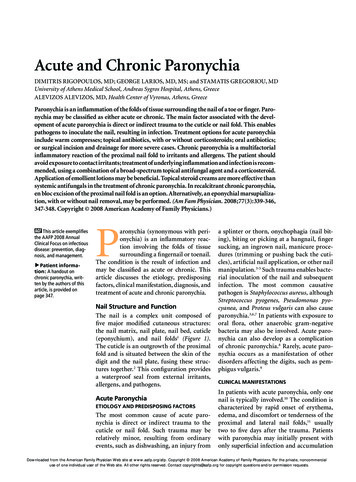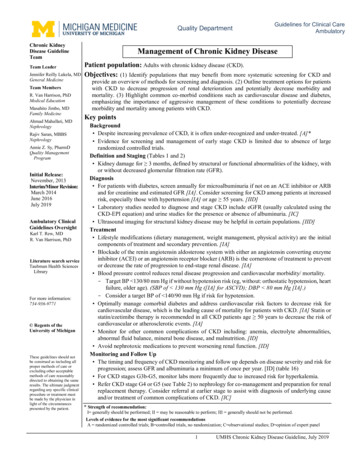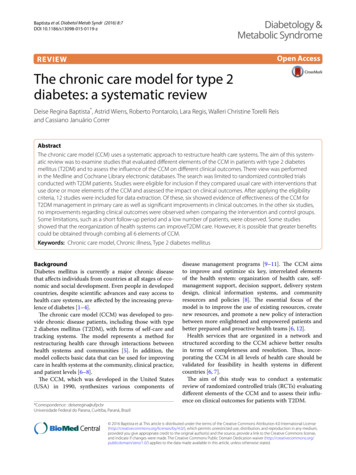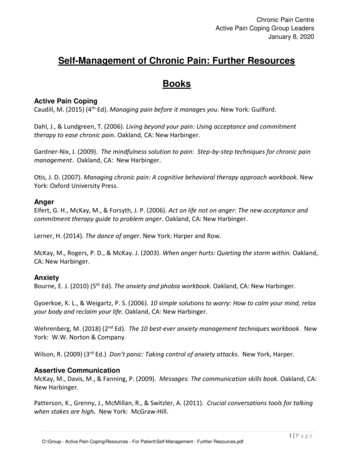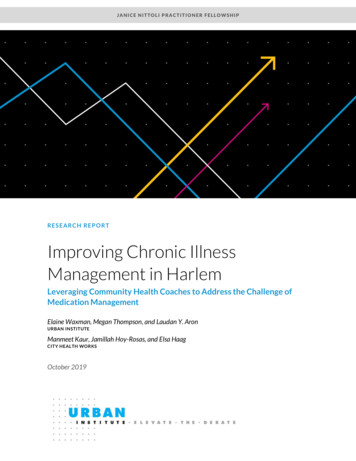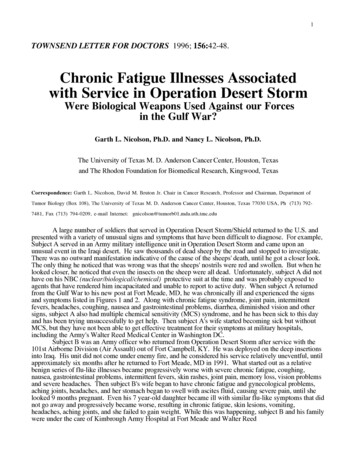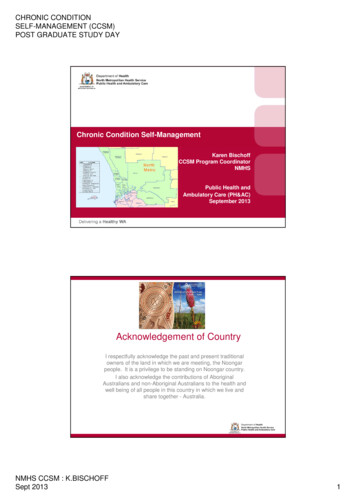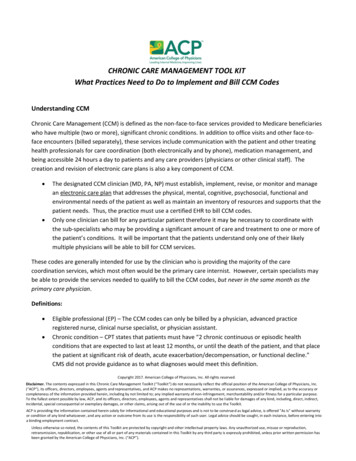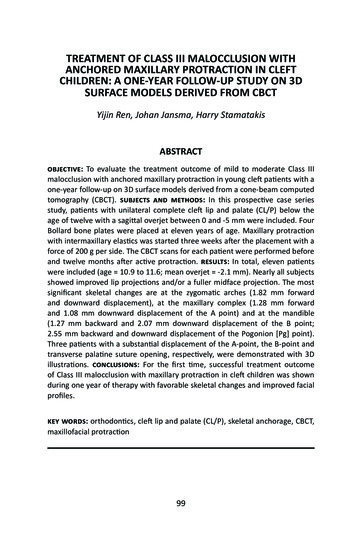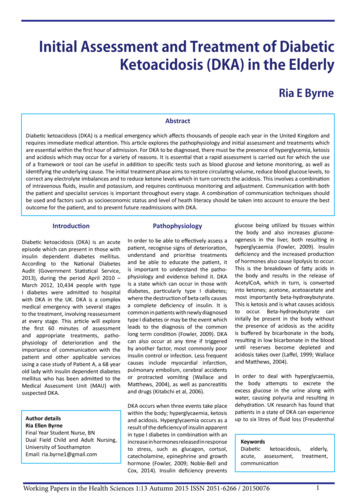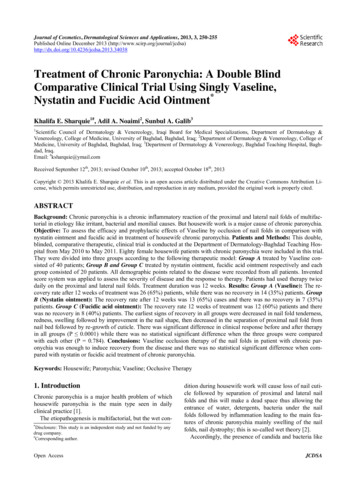
Transcription
Journal of Cosmetics, Dermatological Sciences and Applications, 2013, 3, 250-255Published Online December 2013 org/10.4236/jcdsa.2013.34038Treatment of Chronic Paronychia: A Double BlindComparative Clinical Trial Using Singly Vaseline,Nystatin and Fucidic Acid Ointment*Khalifa E. Sharquie1#, Adil A. Noaimi2, Sunbul A. Galib31Scientific Council of Dermatology & Venereology, Iraqi Board for Medical Specializations, Department of Dermatology &Venereology, College of Medicine, University of Baghdad, Baghdad, Iraq; 2Department of Dermatology & Venereology, College ofMedicine, University of Baghdad, Baghdad, Iraq; 3Department of Dermatology & Venereology, Baghdad Teaching Hospital, Baghdad, Iraq.Email: #ksharquie@ymail.comReceived September 12th, 2013; revised October 10th, 2013; accepted October 18th, 2013Copyright 2013 Khalifa E. Sharquie et al. This is an open access article distributed under the Creative Commons Attribution License, which permits unrestricted use, distribution, and reproduction in any medium, provided the original work is properly cited.ABSTRACTBackground: Chronic paronychia is a chronic inflammatory reaction of the proximal and lateral nail folds of multifactorial in etiology like irritant, bacterial and monilial causes. But housewife work is a major cause of chronic paronychia.Objective: To assess the efficacy and prophylactic effects of Vaseline by occlusion of nail folds in comparison withnystatin ointment and fucidic acid in treatment of housewife chronic paronychia. Patients and Methods: This double,blinded, comparative therapeutic, clinical trial is conducted at the Department of Dermatology-Baghdad Teaching Hospital from May 2010 to May 2011. Eighty female housewife patients with chronic paronychia were included in this trial.They were divided into three groups according to the following therapeutic model: Group A treated by Vaseline consisted of 40 patients; Group B and Group C treated by nystatin ointment, fucidic acid ointment respectively and eachgroup consisted of 20 patients. All demographic points related to the disease were recorded from all patients. Inventedscore system was applied to assess the severity of disease and the response to therapy. Patients had used therapy twicedaily on the proximal and lateral nail folds. Treatment duration was 12 weeks. Results: Group A (Vaseline): The recovery rate after 12 weeks of treatment was 26 (65%) patients, while there was no recovery in 14 (35%) patients. GroupB (Nystatin ointment): The recovery rate after 12 weeks was 13 (65%) cases and there was no recovery in 7 (35%)patients. Group C (Fucidic acid ointment): The recovery rate 12 weeks of treatment was 12 (60%) patients and therewas no recovery in 8 (40%) patients. The earliest signs of recovery in all groups were decreased in nail fold tenderness,redness, swelling followed by improvement in the nail shape, then decreased in the separation of proximal nail fold fromnail bed followed by re-growth of cuticle. There was significant difference in clinical response before and after therapyin all groups (P 0.0001) while there was no statistical significant difference when the three groups were comparedwith each other (P 0.784). Conclusions: Vaseline occlusion therapy of the nail folds in patient with chronic paronychia was enough to induce recovery from the disease and there was no statistical significant difference when compared with nystatin or fucidic acid treatment of chronic paronychia.Keywords: Housewife; Paronychia; Vaseline; Occlusive Therapy1. IntroductionChronic paronychia is a major health problem of whichhousewife paronychia is the main type seen in dailyclinical practice [1].The etiopathogenesis is multifactorial, but the wet conDisclosure: This study is an independent study and not funded by anydrug company.#Corresponding author.*Open Accessdition during housewife work will cause loss of nail cuticle followed by separation of proximal and lateral nailfolds and this will make a dead space thus allowing theentrance of water, detergents, bacteria under the nailfolds followed by inflammation leading to the main features of chronic paronychia mainly swelling of the nailfolds, nail dystrophy; this is so-called wet theory [2].Accordingly, the presence of candida and bacteria likeJCDSA
Treatment of Chronic Paronychia: A Double Blind Comparative Clinical TrialUsing Singly Vaseline, Nystatin and Fucidic Acid OintmentStaph aureus, alpha, beta and gamma-haemolytic Streptococci, Klebsiella pneumonia, Bacteroides species andColiform, Pseudomnas aeruginosa, Proteus species andother organisms as Diphtheroids, Streptococcus fecalis,and Staphphylococcus albus are considered as secondaryinvader in the pathogenesis of chronic paronchia [3].Hence, the aim of therapy is to close the so-called deadspace and encourage the adhesion of nail cuticle and nailfolds thus preventing the entrance of water, detergentsand bacteria. Therefore, the management of chronic paronychia should start by prevention of wet conditions andgiving antimicrobial agents to stop the process of inflammation, but unfortunately, many practicing dermatologists give antifungal, antibacterial drugs for long timeaiming to enhance cure but without stopping the wetconditions, so recurrence is always high [2].Still many housewives do not take the advice of wearing gloves and again will prevent healing of chronic paronychia [4].Accordingly, the aim of present work is to do occlusion of the dead space by Vaseline alone compared withusing antimicrobial agents like fucidic acid and nystatinand to record the therapeutic response to these therapies.2. Patients and MethodsThis double blind comparative therapeutic trial on theeffectiveness of two drugs topically applied on the nailfolds (nystatin and fucidic acid) compared with Vaselineon treatment of housewife chronic paronychia. This wasconducted in the Department of Dermatology and Venereology-Baghdad Teaching Hospital, Baghdad, Iraq fromMay 2010-May 2011.Eighty female patients with house wife chronic paronychia were enrolled in this study. Inclusion criteriaincluded all patients with housewife chronic paronychiawho attended for therapy. The diagnosis of chronic paronychia was established according to the following criteria: housewife patients, absence of cuticle associatedwith swelling and erythema of proximal and lateral nailfolds, separation of dorsal and lateral nail folds from nailplate. While, exclusion criteria as follow: acute paronychia, infections like tinea unguam, warts, and herpetic whitlow. Also, dermatological diseases that cancause chronic paronychia such as pemphigus vulgaris,psoriasis, and lichen planus, connective tissue diseaseslike systemic lupus erythematosus, discoid lupus erythematosus, dermatomyositis, and scleroderma were excluded. Peripheral vascular disease like perniosis, Burger s disease, Raynaud s disease, patients with immunosuppressive conditions, bone deformities, diabetes mellitus, and conditions requiring systemic or topical use ofcorticosteroids, calcineurin inhibitors, retinoids and proOpen Access251tease inhibitors were not included.A full history was taken from each patient regardingname, age, gender, marital status, residence, social status,job, number of children, using of gloves and washingmachine, right or left hand, baking, smoking. Also duration, number of fingers involved, and type of treatmentused before.All patients were examined regarding right or left handinvolvement or both, number of nails involved, presenceof swelling, tenderness, and purulent discharge, presenceof nail changes as buckled nail plates, transverse ridging,nail discoloration and associated onycholysis or dystrophy.Formal consent was taken from each patient beforestarting the trial of treatment after full explanation ofnature of disease, course, prognosis, complications, nature of drug, method of application, duration of treatmentand follow up and the ethical approval was obtained fromScientific Council of Dermatology and Venereology,Iraqi Board for Medical Specializations.Evaluation of the patients was done to re-evaluate thedisease score and report any side effects from treatmentclinically and by photograph during study period of 12weeks.All patients were photographed by a digital camera asa baseline and then on 12 weeks, in the same place withfixed illumination and distance by using a digital camera(Sony: Cyber shoot with resolution 12 mega pixels).The following scoring system of the chronic paronychia was invented:1) Loss of cuticle score 12) Separation of proximal nail fold from nail bed withdifferent grades and this was measured by orangestick introduced under the nail folds:a. Separation just score 1b. Separation 2 mm score 2c. Separation 2 mm score 33) Swollen nail fold:a. Swollen just score 1b. Swollen red score 2c. Swollen tender score 34) Secondary nail changes:a. Ridging score 1b. Dystrophy score 3When patients had multiple fingers involvement, theseverely affected one was scored only and the others although treated they were not counted within scoring.The treatment protocol: Patients were divided into 3groups:Group A: using topical white petrolatum (Vaseline )manufactured by Anglo-Dutch Company Unilever.Group B: using topical nystatin ointment in Vaselinebase (Mycodin ) is manufactured by The State CompanyJCDSA
Treatment of Chronic Paronychia: A Double Blind Comparative Clinical TrialUsing Singly Vaseline, Nystatin and Fucidic Acid Ointment252for Drug Industries and Medical Appliances NinavahaIraq, under license of SDI Co.15 grams tube. Each gramcontains nystatin 100.000 I.U of the ointment.Group C: using topical fucidic acid ointment in Vaseline base (Fusibact ) manufactured by Jamjoom Pharma.15 grams tube.Each 100 gram of the ointment contains the active substance sodium fusidate, which corresponds to 2 gramsodium fusidate.The treatment was applied twice daily on the proximaland lateral nail folds. Treatment duration was 12 weeks.All patients were advised to avoid cuticle trimming, nailbiting, picking, trauma and also were encouraged to userubber gloves with inner cotton lining for householdtasks.Statistical analysis was carried out using paired t-testto compare differences before and after treatment in eachgroup. Chi–square test was used to check relations between results either recovery or no recovery. P value lessthan 0.05 was considered significant. SPSS (statisticalpackage for social sciences) version 17 was used for theanalysis.3. ResultsEighty housewife patients with chronic paronychia werecompleted the study their ages ranged from 15 - 68 withmean SD of 37.26 11.06 years. The role of contributing factors showed that moisture; super hydration, detergents and rough work played the highest role in damaging the nail cuticle and nail folds in all patients. Duration of disease ranged from half year- 12 years withmean SD of 2.166 2.66 years. Total numbers of 184fingers involved in 3 groups. Number of finger involvedranged from (1 - 8) with mean SD of 2 9.61 fingers.The nail changes in patients of chronic paronychia demonstrated in (Table 1).Patients in Group A were treated by White petrolatumointment; forty house wife patients were included in thisgroup, their ages ranged from 15 - 60 years with mean SD of 36.37 10.8 years. Married females were 32(80%) patients. They had (0 - 8) children with mean of 4children. Twenty seven (67.5%) patients were usingwashing machine, while only 3 (7.5%) patients were using gloves. Twenty (50%) patients were baking regularly.All of them were right handed 40 (100%). Duration ofdisease ranged from less than 1 year - 12 years withmean SD of 2.6 3.44 years. Total number of 88 fingers was involved.Right hand alone was involved in 29 (72.5%), whileboth right and left hands were involved in 11 (27.5%).Number of finger involved ranged from (1 - 7) withmean SD of 2 1.55 finger. Seventeen (42.5%) patients with 1 finger involvement, 8 (20%) patients with 2fingers, 8 (20%) patients with 3 fingers, 4 (10%) patientswith 4 fingers, 3 (7.5%) patients with 6 fingers. No anyside effect reported from treatment. Most commonly involved finger in right hand was middle finger 22 (55%)followed by thumb 19 (47.5%), ring finger 18 (45%),index 13 (32.5%) with no little finger involvement.While in left hand most common finger involved wasthumb 7 (17.5%), both middle and ring fingers 4 (10%)and index only 1 (2.5%).Patients in Group B were treated by nystatin ointment;twenty house wife patients were included in this group,their ages ranged from 19-55 years with mean SD of37.40 10.75 years. Married females were 18 (90%)patients. They had (0 - 7) children with a mean of 3 children. Twelve (60%) patients were using washing machine. Three (15%) patients were using gloves. Ten(50%) patients were baking regularly.All of them were right handed 20 (100%). Duration ofdisease ranged from less than 1 year - 12 years withTable 1. The nail changes in patients of chronic paronychia at presentation.Group A (Vaseline)Group B (Nystatin ointment)Group C (Fucidic acid ointment)No.%No.%No.%Loss of cuticle401002010020100Nail fold swelling401002010020100Separation of nail fold from nail plate401002010020100Transverse ridging39952010020100Longitudinal ridging820210210Nail pitting287013651050Onycholysis82015210Nail plate dystrophy512.5315210Color changes348517851575Open AccessJCDSA
Treatment of Chronic Paronychia: A Double Blind Comparative Clinical TrialUsing Singly Vaseline, Nystatin and Fucidic Acid Ointmentmean SD of 1.98 2.74 years. Total number of 39 fingers was involved. Number of finger involved rangedfrom (1 - 8) with mean of SD of 2 1.71 fingers, thirteen (65%) patients with 1 finger involvement, 2 (10%)patients with 2 fingers, 3 (15%) patients with 3 fingers, 1(5%) patient with 4 fingers, 1 (5%) patient with 8 fingers.No any side effect reported from treatment. Right h
cause chronic paronychia such as pemphigus vulgaris, psoriasis, and lichen planus, connective tissue diseases like systemic lupus erythematosus, discoid lupus erythe- matosus, dermatomyositis, and scleroderma were ex- cluded. Peripheral vascular disease like perniosis, Bur- ger s disease, Raynaud s disease, patients with immuno- suppressive conditions, bone deformities, diabetes melli- tus .
